Du Su
Token-Level Policy Optimization: Linking Group-Level Rewards to Token-Level Aggregation via Markov Likelihood
Oct 10, 2025Abstract:Group Relative Policy Optimization (GRPO) has significantly advanced the reasoning ability of large language models (LLMs), particularly by boosting their mathematical performance. However, GRPO and related entropy-regularization methods still face challenges rooted in the sparse token rewards inherent to chain-of-thought (CoT). Current approaches often rely on undifferentiated token-level entropy adjustments, which frequently lead to entropy collapse or model collapse. In this work, we propose TEPO, a novel token-level framework that incorporates Markov Likelihood (sequence likelihood) links group-level rewards with tokens via token-level aggregation. Experiments show that TEPO consistently outperforms existing baselines across key metrics (including @k and accuracy). It not only sets a new state of the art on mathematical reasoning tasks but also significantly enhances training stability.
Fine-tuning Done Right in Model Editing
Sep 26, 2025
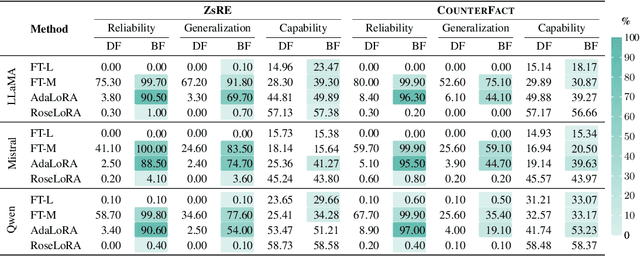
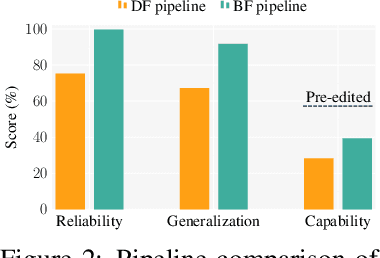
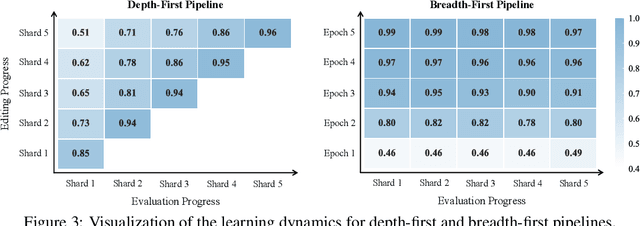
Abstract:Fine-tuning, a foundational method for adapting large language models, has long been considered ineffective for model editing. Here, we challenge this belief, arguing that the reported failure arises not from the inherent limitation of fine-tuning itself, but from adapting it to the sequential nature of the editing task, a single-pass depth-first pipeline that optimizes each sample to convergence before moving on. While intuitive, this depth-first pipeline coupled with sample-wise updating over-optimizes each edit and induces interference across edits. Our controlled experiments reveal that simply restoring fine-tuning to the standard breadth-first (i.e., epoch-based) pipeline with mini-batch optimization substantially improves its effectiveness for model editing. Moreover, fine-tuning in editing also suffers from suboptimal tuning parameter locations inherited from prior methods. Through systematic analysis of tuning locations, we derive LocFT-BF, a simple and effective localized editing method built on the restored fine-tuning framework. Extensive experiments across diverse LLMs and datasets demonstrate that LocFT-BF outperforms state-of-the-art methods by large margins. Notably, to our knowledge, it is the first to sustain 100K edits and 72B-parameter models,10 x beyond prior practice, without sacrificing general capabilities. By clarifying a long-standing misconception and introducing a principled localized tuning strategy, we advance fine-tuning from an underestimated baseline to a leading method for model editing, establishing a solid foundation for future research.
LLM4MEA: Data-free Model Extraction Attacks on Sequential Recommenders via Large Language Models
Jul 22, 2025Abstract:Recent studies have demonstrated the vulnerability of sequential recommender systems to Model Extraction Attacks (MEAs). MEAs collect responses from recommender systems to replicate their functionality, enabling unauthorized deployments and posing critical privacy and security risks. Black-box attacks in prior MEAs are ineffective at exposing recommender system vulnerabilities due to random sampling in data selection, which leads to misaligned synthetic and real-world distributions. To overcome this limitation, we propose LLM4MEA, a novel model extraction method that leverages Large Language Models (LLMs) as human-like rankers to generate data. It generates data through interactions between the LLM ranker and target recommender system. In each interaction, the LLM ranker analyzes historical interactions to understand user behavior, and selects items from recommendations with consistent preferences to extend the interaction history, which serves as training data for MEA. Extensive experiments demonstrate that LLM4MEA significantly outperforms existing approaches in data quality and attack performance, reducing the divergence between synthetic and real-world data by up to 64.98% and improving MEA performance by 44.82% on average. From a defensive perspective, we propose a simple yet effective defense strategy and identify key hyperparameters of recommender systems that can mitigate the risk of MEAs.
Knowledgeable-r1: Policy Optimization for Knowledge Exploration in Retrieval-Augmented Generation
Jun 05, 2025

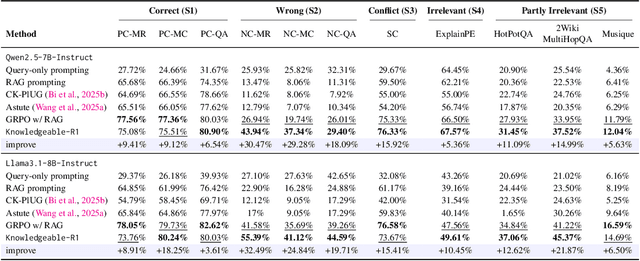
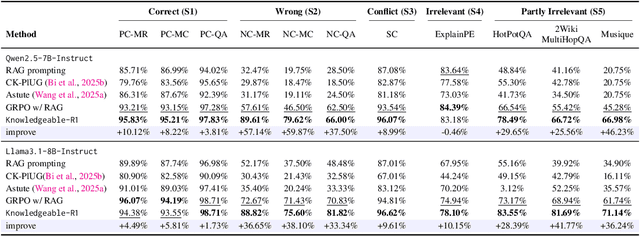
Abstract:Retrieval-augmented generation (RAG) is a mainstream method for improving performance on knowledge-intensive tasks. However,current RAG systems often place too much emphasis on retrieved contexts. This can lead to reliance on inaccurate sources and overlook the model's inherent knowledge, especially when dealing with misleading or excessive information. To resolve this imbalance, we propose Knowledgeable-r1 that using joint sampling and define multi policy distributions in knowledge capability exploration to stimulate large language models'self-integrated utilization of parametric and contextual knowledge. Experiments show that Knowledgeable-r1 significantly enhances robustness and reasoning accuracy in both parameters and contextual conflict tasks and general RAG tasks, especially outperforming baselines by 17.07% in counterfactual scenarios and demonstrating consistent gains across RAG tasks. Our code are available at https://github.com/lcy80366872/ knowledgeable-r1.
Too Consistent to Detect: A Study of Self-Consistent Errors in LLMs
May 23, 2025Abstract:As large language models (LLMs) often generate plausible but incorrect content, error detection has become increasingly critical to ensure truthfulness. However, existing detection methods often overlook a critical problem we term as self-consistent error, where LLMs repeatly generate the same incorrect response across multiple stochastic samples. This work formally defines self-consistent errors and evaluates mainstream detection methods on them. Our investigation reveals two key findings: (1) Unlike inconsistent errors, whose frequency diminishes significantly as LLM scale increases, the frequency of self-consistent errors remains stable or even increases. (2) All four types of detection methshods significantly struggle to detect self-consistent errors. These findings reveal critical limitations in current detection methods and underscore the need for improved methods. Motivated by the observation that self-consistent errors often differ across LLMs, we propose a simple but effective cross-model probe method that fuses hidden state evidence from an external verifier LLM. Our method significantly enhances performance on self-consistent errors across three LLM families.
The 1st Workshop on Human-Centered Recommender Systems
Nov 22, 2024
Abstract:Recommender systems are quintessential applications of human-computer interaction. Widely utilized in daily life, they offer significant convenience but also present numerous challenges, such as the information cocoon effect, privacy concerns, fairness issues, and more. Consequently, this workshop aims to provide a platform for researchers to explore the development of Human-Centered Recommender Systems~(HCRS). HCRS refers to the creation of recommender systems that prioritize human needs, values, and capabilities at the core of their design and operation. In this workshop, topics will include, but are not limited to, robustness, privacy, transparency, fairness, diversity, accountability, ethical considerations, and user-friendly design. We hope to engage in discussions on how to implement and enhance these properties in recommender systems. Additionally, participants will explore diverse evaluation methods, including innovative metrics that capture user satisfaction and trust. This workshop seeks to foster a collaborative environment for researchers to share insights and advance the field toward more ethical, user-centric, and socially responsible recommender systems.
The Fall of ROME: Understanding the Collapse of LLMs in Model Editing
Jun 17, 2024Abstract:Despite significant progress in model editing methods, their application in real-world scenarios remains challenging as they often cause large language models (LLMs) to collapse. Among them, ROME is particularly concerning, as it could disrupt LLMs with only a single edit. In this paper, we study the root causes of such collapse. Through extensive analysis, we identify two primary factors that contribute to the collapse: i) inconsistent handling of prefixed and unprefixed keys in the parameter update equation may result in very small denominators, causing excessively large parameter updates; ii) the subject of collapse cases is usually the first token, whose unprefixed key distribution significantly differs from the prefixed key distribution in autoregressive transformers, causing the aforementioned issue to materialize. To validate our analysis, we propose a simple yet effective approach: uniformly using prefixed keys during editing phase and adding prefixes during the testing phase. The experimental results show that the proposed solution can prevent model collapse while maintaining the effectiveness of the edits.
Unlink to Unlearn: Simplifying Edge Unlearning in GNNs
Feb 16, 2024Abstract:As concerns over data privacy intensify, unlearning in Graph Neural Networks (GNNs) has emerged as a prominent research frontier in academia. This concept is pivotal in enforcing the right to be forgotten, which entails the selective removal of specific data from trained GNNs upon user request. Our research focuses on edge unlearning, a process of particular relevance to real-world applications, owing to its widespread applicability. Current state-of-the-art approaches like GNNDelete can eliminate the influence of specific edges, yet our research has revealed a critical limitation in these approaches, termed over-forgetting. It occurs when the unlearning process inadvertently removes excessive information beyond specific data, leading to a significant decline in prediction accuracy for the remaining edges. To address this issue, we have identified the loss functions of GNNDelete as the primary source of the over-forgetting phenomenon. Furthermore, our analysis also suggests that loss functions may not be essential for effective edge unlearning. Building on these insights, we have simplified GNNDelete to develop Unlink-to-Unlearn (UtU), a novel method that facilitates unlearning exclusively through unlinking the forget edges from graph structure. Our extensive experiments demonstrate that UtU delivers privacy protection on par with that of a retrained model while preserving high accuracy in downstream tasks. Specifically, UtU upholds over 97.3% of the retrained model's privacy protection capabilities and 99.8% of its link prediction accuracy. Meanwhile, UtU requires only constant computational demands, underscoring its advantage as a highly lightweight and practical edge unlearning solution.
Prob2Vec: Mathematical Semantic Embedding for Problem Retrieval in Adaptive Tutoring
Mar 21, 2020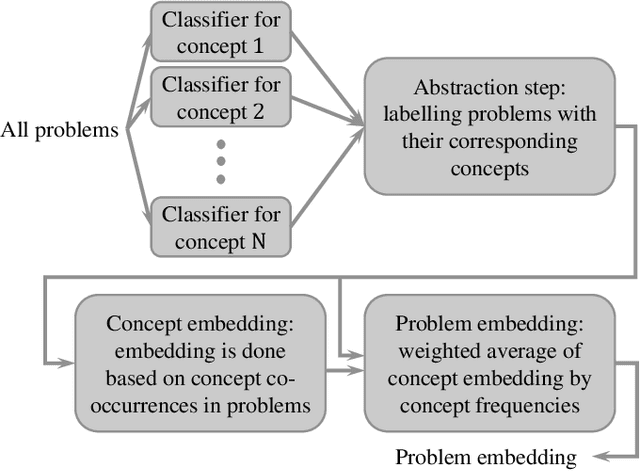
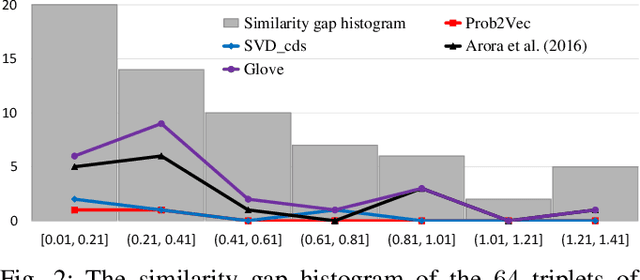
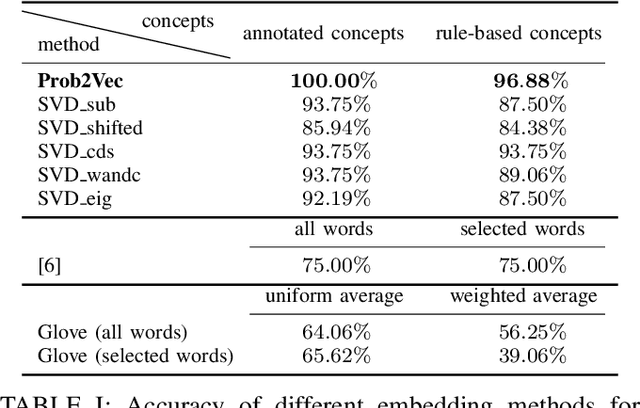

Abstract:We propose a new application of embedding techniques for problem retrieval in adaptive tutoring. The objective is to retrieve problems whose mathematical concepts are similar. There are two challenges: First, like sentences, problems helpful to tutoring are never exactly the same in terms of the underlying concepts. Instead, good problems mix concepts in innovative ways, while still displaying continuity in their relationships. Second, it is difficult for humans to determine a similarity score that is consistent across a large enough training set. We propose a hierarchical problem embedding algorithm, called Prob2Vec, that consists of abstraction and embedding steps. Prob2Vec achieves 96.88\% accuracy on a problem similarity test, in contrast to 75\% from directly applying state-of-the-art sentence embedding methods. It is interesting that Prob2Vec is able to distinguish very fine-grained differences among problems, an ability humans need time and effort to acquire. In addition, the sub-problem of concept labeling with imbalanced training data set is interesting in its own right. It is a multi-label problem suffering from dimensionality explosion, which we propose ways to ameliorate. We propose the novel negative pre-training algorithm that dramatically reduces false negative and positive ratios for classification, using an imbalanced training data set.
 Add to Chrome
Add to Chrome Add to Firefox
Add to Firefox Add to Edge
Add to Edge